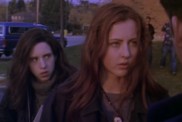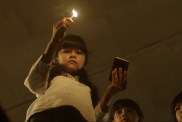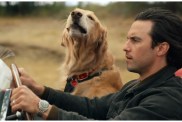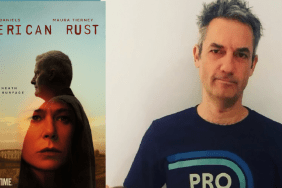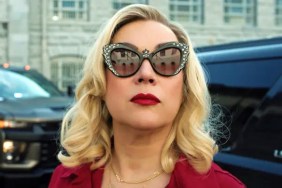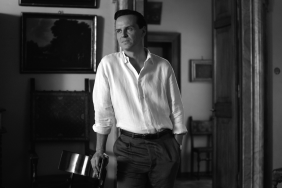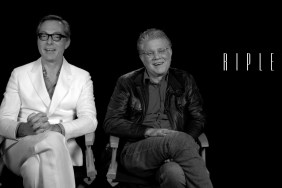Exclusive 1-on-1: Creator Joel Hodgson Talks Bringing Mystery Science Theater Back to Life
Today is a banner day for fans of Mystery Science Theater 3000, as Netflix has dropped all 14 episodes of the new revival season for you to devour right now! To celebrate, ComingSoon.net had the chance to talk to the creative genius behind the show, Joel Hodgson, who created and hosted the first episode in November of 1988 before going on to do 107 episodes before leaving the show in the hands of replacement host Mike Nelson. Now, over two decades after saying goodbye to MST3K, Joel is back as the mastermind behind a new revival of the show, which he launched via the most successful film and TV Kickstarter campaign in history. In our exclusive interview, we talk to Hodgson about the writing process, bringing in new blood, keeping the old cast a part of the show and, of course, we talk about the most infamous episode of all: Manos: The Hands of Fate.
Be sure to check out the gallery below for behind-the-scenes pics from the new season of MST3K, and a listing of all the new bad movies that are riffed this season! Also watch a new clip of the cast riffing hilariously on Netflix’s Stranger Things!
ComingSoon.net: One thing fans are going to really appreciate is, despite all the new technology and the fresh voices and the fact that it’s in widescreen, it still feels exactly like “MST3K.” It’s as if the show had never stopped. In your mind, what were the essentials for recapturing that feeling?
Joel Hodgson: Hrmm… That’s a great question. I think it’s really hard to do that and there’s no way to really control that. I think what I did was, I said, listen, I think “Mystery Science Theater” works because it’s like a document of a couple of days in the life of these people who are making a show. And so, I just tried to keep the stress off and kind of treated it like, listen, we’re just going to go for it. And when we record everything, it’s really just a document of where we are and it’s like a family photo, you know? Family photos, I think they work because they’re imperfect and you go, “Oh yeah, I wasn’t looking at the camera when they took that.” So that was kind of how I dealt with it. It’s just the concept of, “This is a document, it’s just a place in time and we’re not finished. We’re just starting, so let’s not feel like we have to kill it.” So that was my angle on it, just to try to take the stress off, mostly, and I’m really happy with how it ended up. We’re also really fortunate because we obviously had the cast, who really care about the show, but also, a lot of the writers like Elliott Kalan, our head writer. He really loves the show and really cares about it and wants it to be good. We just had all these new people that had a good experience with it and kind of wanted to recreate that for other people, you know?

CS: You made it a point to make this more of a younger, more LA-centric writer’s room led by Elliott Kalan, and you also had guys like Dan Harmon and Matt Oswalt. Having more people from “the biz” in the writer’s room — as opposed to the gang of very, very funny local midwesterners that you had on the original — how did it change the dynamic?
Hodgson: Well, Elliott came up right out of college, started working as an intern on “The Daily Show,” so that was really all he ever knew. I guess now when I think about it, I didn’t think of it as LA-centric as basically everyone is from all over the place. It’s New York, it’s Chicago, it’s Minneapolis, it’s LA. So I don’t really like the LA writing culture, from what I’ve seen of it. We work from an abundance model, and I feel like LA writing rooms kind of work from a scarcity model like, “Come and sit in the room and you’re going to pitch me ideas.” We don’t do that. Our thing is all based on people just being very creative. We generate all the material without editing ever. Like, we wouldn’t have a writing room session where people would be pitching me ideas or Elliott ideas. So we would go, “No, no, no, no, no. Come back at me with something funnier.” Which is what I think LA writing rooms are like, the ones that I’ve been in. We work just the opposite, where we’re together, we don’t say no to anything. We just generate a ton of material, and then later, when we’re done with that, and we’re more in an editorial mode, then we talk about it. But the writers usually aren’t around then, you know what I mean?
CS: Right.
Hodgson: So I avoid editorial—because people did that to me when I was in LA, and it just made me not want to be creative or funny. I want to make a really clear demarcation there about how I feel about it.
CS: Baron told me that a lot of the writing wasn’t even done in a writing room, that it was done separately and then aggregated into a big online file for each movie.
Hodgson: Yeah, yeah, we have two ways of working. We have remote. We have a lot of people write remotely and add to the kind of aggregate riff. And then, we also have writing rooms that are live, like in my office, we have a writing room and we also have virtual people on Skype, who are involved with it. So there was basically two writing rooms. I had a writing room and Elliott had a writing room. Elliott had Jonah. That’s kind of how we did it. So that was more the old school “MST.” Then the new school was a lot of people writing remotely and it just kind of became part of the mass of riffs that we then added as we went along.
CS: Now I don’t know if it was because you were all Midwesterners, but I remember in the original show, there was a preponderance of jokes about food. Does that tradition live on in the new episodes?
Hodgson: Hmmm. That’s so interesting because I’m eating right now.
CS: Of course you are.
Hodgson: No, I mean, I think food has always been such a big part of TV, especially cartoons. Like, for me, I used to love any time Elmer Fudd would see Daffy Duck and see him as a delicious roasted duck, I always got really hungry. Daffy Duck always looked so buttery and delicious. So I just think that’s a tenant of comedy, is food. But I don’t know. I never noticed that and you’re the first person who ever said that, so I never really noticed that, actually.

CS: Yeah, I mean, a part of me used to chalk it up to the fact that Mike worked as a waiter.
Hodgson: Oh that’s funny. Yeah. I don’t know why that is, man. It’s just funny. I think, too, yeah, I don’t know. It’s such a big thing. Like, I used to love food like when there’d be children’s books and you’re a little kid and they do drawings of food, it always looked so delicious. You know, even like the carrots in Peter Cottontail, they’re in the garbage, but when he would pull them out, those carrots looked delicious.
CS: Now there’s some famous filmmakers like Joe Dante and Edgar Wright who have said they don’t actually like “Mystery Science Theater” because they appreciate these B movies too much. Now that I make part of my living writing about obscure trash cinema for our horror site, I would say conversely that I learned to appreciate these movies FROM watching “MST3K.” Where do you stand on the actual movies? Like, do you have an appreciation for them, or do you kind of sort of feel above all of these movies?
Hodgson: Oh, no. I adore them. I just feel like it’s really hard to make a movie, especially the further you go back in time, even to the point where everything was on film, it was excruciatingly hard, even to make a bad movie. And I just think people who act superior or get really snarky, I just don’t think they’ve thought it through and imagine all that goes into making a movie. Naïve consumers think that way, or 13-year olds, you know? My thing is, I love them all, and it’s kind of weird because there’s kind of this Stockholm Syndrome that happens to you, when you spend as much time with them as we do, that you start to love all these movies. I find things I just adore, either just a certain day that they captured, the way the sun looked, or an actor, a female actor or a male actor. Cheryl our operations manager, who writes some episodes, started falling in love with the lead guy in “Reptilicus.” She started to tell me about it. I said, “Yeah, that happens to me with female actors, I just start to fall in love with them over time because you spend so much time in the environment with them.” It’s really crazy. So yeah, I like them and I think that they’re adorable. “Mystery Science Theater” the coloring book version is that we are snarky and we make fun of bad movies because their quality is bad, but the truth is, we just kinda use the movies as a springboard to kinda create a variety show, you know?
CS: Right, exactly. To a certain extent I think there is a culture of film nerds who are my age who are really digging in, doing deep vault dives for a lot of these older movies, just because we have that muscle memory of watching them on “MST3K.”
Hodgson: Thank you. I’m really proud of that and that’s a part of the secret of it. That’s why we didn’t billboard which movies we’re going to show, because that’s not what “Mystery Science Theater” is. It’s the opposite of Hollywood, where Hollywood has to teach you the movie to get your butt in the theater and sell you popcorn. “Mystery Science Theater” is dependent that you probably don’t know much about this movie, and that’s what makes it so fun. It’s kind of like exploring, having some funny friends and deciding you’re going to explore that house that you think might be haunted on the edge of town, you know? If you’ve been in there, if you’ve seen pictures of it, it’s not going to be as fun, you know?
CS: Yeah, exactly. It’s just going to be a sh*tty old house.
Hodgson: So I think that’s true with the criticism, too. It’s something like, it’s just amazing. I don’t know. I mean, number one, we just love to watch people. We love to watch them. Like, if they’re building a building, people are just lined up watching people do stuff, and we just love it. So I think that’s a big part of it.

CS: Right. Now I have probably the most seminal memory of watching the “Manos” episode in the early ’90s when it aired. Now that’s considered the big deal episode, but we watched it the night it aired and felt kind of scarred.
Hodgson: Oh my god, yeah.
CS: It’s one of those movies that I think if you’re only exposed to mainstream movies, it reshapes your conception of what a bad movie is. Which films from the new season do you think have the potential for being a new “Manos,” like a legendarily bad movie?
Hodgson: I really don’t want to say. I want to be very careful about that, because when we did “Manos” we didn’t know it was going to be this acclaimed terrible movie. It wasn’t clear. It was just one of 22 movies we did. I do remember when we were writing it, I remember sitting there saying to myself, “Should I say something? Should I mention how sh*tty this is or is that really irresponsible as an executive producer of the show, of like yelling fire in a crowded theater?” But then, everybody started saying, “Wow, this one is really bad.” And again, you have to think about how we made them. We’d screen a little bit. We’d watch a little bit of it at lunch, and after watching like 10 minutes, we’d go, “Yeah, okay.” But the other thing about my impression of “Manos” is that there is this kind of vibe to it, and I think it has to do with the sound a little bit, the way the sound has this kind of suffocated quality to it, the idea that they only could shoot 35 seconds at a time because of the unique camera they had. They could only have magazines that were maybe a minute long or 30 seconds long. When you’re watching “Manos” you start to wonder if something really terrible is going to happen, and that maybe the person doing it knows exactly what they’re doing. You start to go, “Is this feeling I’m getting because this guy is this horror king, just kind of like the new David Lynch? And he’s about to deliver a scare that’ll make me regret I ever looked at this movie?” And you get that feeling like something terrible is going to happen. And obviously, it never happens.
CS: Right, yeah.
Hodgson: But I think the environment of the movie really makes you go, “I’m really getting anxiety and I can’t tell you why.” That’s why it was so weird when they tried to re-master it and all that weird stuff. I’m going, “You know, you’re missing the point. The reason why we’re fascinated is because there’s something weird with the sound and there’s something weird with the picture.” If you go in and correct that, you’re just going to have a nicer looking movie and it’s not going to have the mystery and it’s just got this kind of choking quality to it that’s very weird. That’s my take on it. There’s this quality. It’s like, usually we get our thoughts on the movies, when we do “Mystery Science Theater,” but in the situation of “Manos,” it got its thoughts on us. It’s so weird and so special, but it’s a complete misunderstanding and I believe it’s a complete accident.
CS: Yeah. Well, I mean, as you said in the episode, “The entire movie looks like someone’s last known photograph.”
Hodgson: Yeah, yeah, exactly.
CS: Now I’d actually seen “Reptilicus” prior to the show, and I remembered this wonderfully inexplicable scene that’s like a tourism film for Copenhagen, just in the middle of this monster movie.
Hodgson: Yeah, we had to cut that. It was really amazing, and they stopped and they go to a restaurant and someone sings a song and it’s wild. I just think we had to cut it. It was one of those things where I was sitting there going, “Yeah, it’s so fantastic, but it’s hard to riff during a song.” So I think that’s why it got cut.

CS: It was cool to see Mary Jo Pehl, Kevin Murphy and Bill Corbett do their cameo in the flying VW. Was it important for you to acknowledge the whole of “MST3K” and not simply your years on the show?
Hodgson: Oh my god, yeah. I mean, that was like a really big issue when we did the Kickstarter. My idea was six weeks before we shot the video for the Kickstarter, everyone was involved. Like Trace, Frank, Mary Jo and Felicia [Day] were all going to be in the trailer. So we were booking air travel and I’d written a script and sent it out. The premise was going to be originally Dr. Forrester, TV’s Frank, Pearl Forrester, and Felicia were all kind of in the film and in my mind, it was going to be kind of like “The Addams Family.” Felicia had a little bit smaller of a part, and then prior it all fell apart and for different reasons everyone from the original cast kind of passed on getting involved with the Kickstarter. And so, I was kind of confronted with, “Oh, I guess we’re just going to have to lead with all the new people, with Baron and Hampton and Jonah and Felicia.” And that’s when I kind of thought, “Oh yeah, if Trace and Frank aren’t going to be in this, I’ve got to have another mad for Felicia,” so that’s when the idea of approaching Patton [Oswalt] came along. So that’s kind of the construction of it.
And then, once we got on the other side of the Kickstarter, then we were able to get Kevin and Bill and Mary Jo involved, and that’s how that happened. But at the same time, when we did the Kickstarter, people are going, “What’s going on? Where are all the other people? Why are you doing this without them? What’s happening?” We had to, in an elegant way, go, “Well, we’ve invited them and hopefully they’ll come back,” but we had to kind of lean into the idea of refreshing it and using new people. We were kind of forced to lead with that, with new people, but having them back was really great and they were very gracious. All the crew and the writers and performers were really excited they were there. They got a lot of attention from everyone, so I think everybody really loved that they’re a part of it. They did an awesome job, and Mary Jo and Bill wrote on a couple of episodes, too, as well as Paul Chaplin, who was a longtime writer on the show.
CS: That’s really cool. I was also glad to see the invention exchange come back, because I know that was part of your comedy act that was integrated into the original show. A lot of those were inventions that you’d come up with in college and sort of had in your back pocket. Were you the big force behind these new inventions?
Hodgson: Well, we did them with a group. I kind of, honestly burned through a lot of my ideas for inventions back in the day. I think we did almost 200 of them. So this time around I wasn’t going to do the invention exchange, and everybody in the office is going, “Come on. You’ve got to do invention exchange.” I go, “Really? It takes two minutes. It’s two minutes longer. Don’t you want to get to the movie riffing?” And they go, “Oh, you gotta do it.” So we did it as a group, hammered them out among the writers. But I don’t know, I may have done half of them. The rest of them were the writers.
CS: So it’s still got your touch on it.
Hodgson: A few of them, yeah. I think I did about half of them, now that I think about it.
Mystery Science Theater 3000
-
Episode 1101: Reptilicus

-
Episode 1102: Cry Wilderness

-
Episode 1103: The Time Travelers

-
Episode 1104: Avalanche

-
Episode 1105: The Beast of Hollow Mountain

-
Episode 1106: Starcrash

-
Episode 1107: The Land That Time Forgot

-
Episode 1108: The Loves of Hercules

-
Episode 1109: Yongary - Monster from the Deep

-
Episode 1110: Wizards of the Lost Kingdom

-
Episode 1111: Wizards of the Lost Kingdom II

-
Episode 1112: Carnival Magic

-
Episode 1113: Il Natale Che Quasi Non Fu

-
Episode 1114: At the Earth's Core

-
Mystery Science Theater 3000

'Mystery Science Theater 3000' starring Jonah Ray, Patton Oswalt, Felicia Day, Bill Corbett, Kevin Murphy, Mary Jo Pehl, Hampton Yount, Baron Vaughn, Rebecca Hanson, Tim Blaney, Elliot Kalan. Directed by Joel Hodgson & Rob Cohen. Photo by Darren Michaels, SMPSP
-
Mystery Science Theater 3000

'Mystery Science Theater 3000' starring Jonah Ray, Patton Oswalt, Felicia Day, Bill Corbett, Kevin Murphy, Mary Jo Pehl, Hampton Yount, Baron Vaughn, Rebecca Hanson, Tim Blaney, Elliot Kalan. Directed by Joel Hodgson & Rob Cohen. Photo by Darren Michaels, SMPSP
-
Mystery Science Theater 3000

'Mystery Science Theater 3000' starring Mark Hamill, Jonah Ray, Hampton Yount, Baron Vaughn, Rebecca Hanson, Tim Blaney, Joel Hodgson, & Elliot Kalan. Photo by Darren Michaels, SMPSP
-
Mystery Science Theater 3000

'Mystery Science Theater 3000' starring Joel Mchale, Jonah Ray, Bill Corbett, Kevin Murphy, Mary Jo Pehl, Hampton Yount, Baron Vaughn, Rebecca Hanson, Tim Blaney, Elliot Kalan. Directed by Joel Hodgson & Rob Cohen. Photo by Darren Michaels, SMPSP
-
Mystery Science Theater 3000

'Mystery Science Theater 3000' starring Joel Mchale, Jonah Ray, Bill Corbett, Kevin Murphy, Mary Jo Pehl, Hampton Yount, Baron Vaughn, Rebecca Hanson, Tim Blaney, Elliot Kalan. Directed by Joel Hodgson & Rob Cohen. Photo by Darren Michaels, SMPSP
-
Mystery Science Theater 3000

'Mystery Science Theater 3000' starring Jonah Ray, Patton Oswalt, Felicia Day, Bill Corbett, Kevin Murphy, Mary Jo Pehl, Hampton Yount, Baron Vaughn, Rebecca Hanson, Tim Blaney, Elliot Kalan. Directed by Joel Hodgson & Rob Cohen. Photo by Darren Michaels, SMPSP
-
Mystery Science Theater 3000

'Mystery Science Theater 3000' starring Jonah Ray, Patton Oswalt, Felicia Day, Bill Corbett, Kevin Murphy, Mary Jo Pehl, Hampton Yount, Baron Vaughn, Rebecca Hanson, Tim Blaney, Elliot Kalan. Directed by Joel Hodgson & Rob Cohen. Photo by Darren Michaels, SMPSP
-
Mystery Science Theater 3000

'Mystery Science Theater 3000' starring Jonah Ray, Patton Oswalt, Felicia Day, Bill Corbett, Kevin Murphy, Mary Jo Pehl, Hampton Yount, Baron Vaughn, Rebecca Hanson, Tim Blaney, Elliot Kalan. Directed by Joel Hodgson & Rob Cohen. Photo by Darren Michaels, SMPSP
-
Mystery Science Theater 3000

'Mystery Science Theater 3000' starring Jonah Ray, Hampton Yount, Baron Vaughn, Rebecca Hanson, Tim Blaney, Joel Hodgson, & Elliot Kalan. Photo by Darren Michaels, SMPSP for Satellite of Love, LLC © 2016
-
Mystery Science Theater 3000

'Mystery Science Theater 3000' starring Jonah Ray, Patton Oswalt, Felicia Day, Bill Corbett, Kevin Murphy, Mary Jo Pehl, Hampton Yount, Baron Vaughn, Rebecca Hanson, Tim Blaney, Elliot Kalan. Directed by Joel Hodgson & Rob Cohen. Photo by Darren Michaels, SMPSP
-
Mystery Science Theater 3000

'Mystery Science Theater 3000' starring Jonah Ray, Hampton Yount, Baron Vaughn, Rebecca Hanson, Tim Blaney, Joel Hodgson, & Elliot Kalan. Photo by Darren Michaels, SMPSP for Satellite of Love, LLC © 2016
-
Mystery Science Theater 3000

'Mystery Science Theater 3000' starring Jonah Ray, Patton Oswalt, Felicia Day, Bill Corbett, Kevin Murphy, Mary Jo Pehl, Hampton Yount, Baron Vaughn, Rebecca Hanson, Tim Blaney, Elliot Kalan. Directed by Joel Hodgson & Rob Cohen. Photo by Darren Michaels, SMPSP
-
Mystery Science Theater 3000

'Mystery Science Theater 3000' starring Jonah Ray, Hampton Yount, Baron Vaughn, Rebecca Hanson, Tim Blaney, Joel Hodgson, & Elliot Kalan. Photo by Darren Michaels, SMPSP for Satellite of Love, LLC © 2016
-
Mystery Science Theater 3000

'Mystery Science Theater 3000' starring Jonah Ray, Hampton Yount, Baron Vaughn, Rebecca Hanson, Tim Blaney, Joel Hodgson, & Elliot Kalan. Photo by Darren Michaels, SMPSP for Satellite of Love, LLC © 2016
-
Mystery Science Theater 3000

'Mystery Science Theater 3000' starring Jonah Ray, Hampton Yount, Baron Vaughn, Rebecca Hanson, Tim Blaney, Joel Hodgson, & Elliot Kalan. Photo by Darren Michaels, SMPSP for Satellite of Love, LLC © 2016
-
Mystery Science Theater 3000

'Mystery Science Theater 3000' starring Jonah Ray, Patton Oswalt, Felicia Day, Bill Corbett, Kevin Murphy, Mary Jo Pehl, Hampton Yount, Baron Vaughn, Rebecca Hanson, Tim Blaney, Elliot Kalan. Directed by Joel Hodgson & Rob Cohen. Photo by Darren Michaels, SMPSP
-
Mystery Science Theater 3000

'Mystery Science Theater 3000' starring Jonah Ray, Patton Oswalt, Felicia Day, Bill Corbett, Kevin Murphy, Mary Jo Pehl, Hampton Yount, Baron Vaughn, Rebecca Hanson, Tim Blaney, Elliot Kalan. Directed by Joel Hodgson & Rob Cohen. Photo by Darren Michaels, SMPSP
-
Mystery Science Theater 3000

'Mystery Science Theater 3000' starring Jonah Ray, Hampton Yount, Baron Vaughn, Rebecca Hanson, Tim Blaney, Joel Hodgson, & Elliot Kalan. Photo by Darren Michaels, SMPSP
-
Mystery Science Theater 3000

'Mystery Science Theater 3000' starring Jonah Ray, Hampton Yount, Baron Vaughn, Rebecca Hanson, Tim Blaney, Joel Hodgson, & Elliot Kalan. Photo by Darren Michaels, SMPSP
-
Mystery Science Theater 3000

'Mystery Science Theater 3000' starring Jonah Ray, Patton Oswalt, Felicia Day, Bill Corbett, Kevin Murphy, Mary Jo Pehl, Hampton Yount, Baron Vaughn, Rebecca Hanson, Tim Blaney, Elliot Kalan. Directed by Joel Hodgson & Rob Cohen. Photo by Darren Michaels, SMPSP
-
Mystery Science Theater 3000

'Mystery Science Theater 3000' starring Jonah Ray, Patton Oswalt, Felicia Day, Bill Corbett, Kevin Murphy, Mary Jo Pehl, Hampton Yount, Baron Vaughn, Rebecca Hanson, Tim Blaney, Elliot Kalan. Directed by Joel Hodgson & Rob Cohen. Photo by Darren Michaels, SMPSP
-
Mystery Science Theater 3000

'Mystery Science Theater 3000' starring Jonah Ray, Patton Oswalt, Felicia Day, Bill Corbett, Kevin Murphy, Mary Jo Pehl, Hampton Yount, Baron Vaughn, Rebecca Hanson, Tim Blaney, Elliot Kalan. Directed by Joel Hodgson & Rob Cohen. Photo by Darren Michaels, SMPSP
-
Mystery Science Theater 3000

'Mystery Science Theater 3000' starring Jonah Ray, Patton Oswalt, Felicia Day, Bill Corbett, Kevin Murphy, Mary Jo Pehl, Hampton Yount, Baron Vaughn, Rebecca Hanson, Tim Blaney, Elliot Kalan. Directed by Joel Hodgson & Rob Cohen. Photo by Darren Michaels, SMPSP
-
Mystery Science Theater 3000

'Mystery Science Theater 3000' starring Jonah Ray, Hampton Yount, Baron Vaughn, Rebecca Hanson, Tim Blaney, Joel Hodgson, & Elliot Kalan. Photo by Darren Michaels, SMPSP for Satellite of Love, LLC © 2016
-
Mystery Science Theater 3000

'Mystery Science Theater 3000' starring Jonah Ray, Hampton Yount, Baron Vaughn, Rebecca Hanson, Tim Blaney, Joel Hodgson, & Elliot Kalan. Photo by Darren Michaels, SMPSP for Satellite of Love, LLC © 2016
-
Mystery Science Theater 3000

'Mystery Science Theater 3000' starring Jonah Ray, Hampton Yount, Baron Vaughn, Rebecca Hanson, Tim Blaney, Joel Hodgson, & Elliot Kalan. Photo by Darren Michaels, SMPSP for Satellite of Love, LLC © 2016
